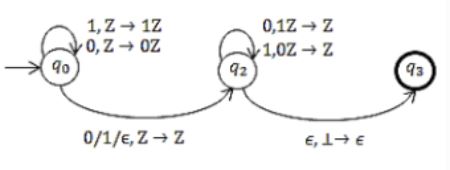Question 8185 – GATE 2015 [Set-1]
February 4, 2024Operating-Systems
February 4, 2024Question 8188 – GATE 2015 [Set-1]
Consider the NPDA 〈Q = {q0, q1, q2}, Σ = {0, 1}, Γ = {0, 1, ⊥}, δ, q0, ⊥, F = {q2}〉, where (as per usual convention) Q is the set of states, Σ is the input alphabet, Γ is stack alphabet, δ is the state transition function, q0 is the initial state, ⊥ is the initial stack symbol, and F is the set of accepting states, The state transition is as follows:

Correct Answer: B
Question 31 Explanation:
In q0 state for ‘1’, a ‘1’ is pushed and for a ‘0’, a ‘0’ is pushed. In q1 state, for a ‘0’ a ‘1’ is popped, and for ‘1’ a ‘0’ is popped. So the given PDA is accepting all strings of form x0(xr)’ or x1(xr)’ or x(xr)’ , where (xr)’ is the complement of reverse of x.
10110
10010
01010
01001
Subscribe
Login
0 Comments
![Question 8188 – GATE 2015 [Set-1]](https://solutionsadda.in/wp-content/uploads/2019/05/green-new-logo.png)